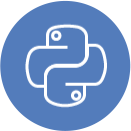Our Alumni Work At

"AI to contribute $16.1 trillion to the global economy by 2030. With 133 million more engaging, less repetitive jobs AI to change the workforce." - (Source). Data Science with Artificial Intelligence (AI) is a revolution in the business industry.. AI is potentially being adopted in automating many jobs leading to higher productivity, less cost, and extensible solutions. It is reported by PWC in a publication that about 50% of human jobs will be taken away by the AI in the next 5 years.
There is already a huge demand for AI specialists and this demand will be exponentially growing in the future. In the past few years, careers in AI have boosted concerning the demands of industries that are digitally transformed. The report of 2018 states that the requirements for AI skills have drastically doubled in the last three years, with job openings in the domain up to 119%.
FAQs
Yes, the data science offline course in Pune is ideal for beginners. It covers foundational concepts and advanced techniques, ensuring that even those without prior experience can successfully pursue a career in data science.
You must have passed a Bachelor's degree in Mathematics, Statistics, Computer Science or Data Science. A Bachelor's degree in any engineering discipline is welcome. If you meet these requirements then you are eligible to join this course.
In this blended program, you will be attending 184 hours of classroom sessions of 4 months. After completion, you will have access to the online Learning Management System for another three months for recorded videos and assignments. The total duration of assignments to be completed online is 150 hours. Besides this, you will be working on a live project for a month.
The Data Science using Python and R programming offered by 360DigiTMG is one of the best data science institute in Pune.
Yes. An individual can pursue a data science courses from a reputed institute after graduation. The institute must offer live project exposure via an internship program and possess industry-specific course material.
In Pune, data scientists earn an average salary between INR 6,00,000 and INR 10,00,000 annually. With experience and expertise gained from the best institute for data science in Pune, salaries can increase significantly..
Yes, students completing the data science course in Pune receive a certification. This certification enhances your career prospects by validating your skills and knowledge in data science, making you more competitive in the job market.
Yes. We are proud to announce that we have received the TUV SUD rating of quality for our program.
Yes. Students can avail of our scholarship scheme titled " Jumpstart". 90% scholarship will be bestowed on deserving students.
The topics included in this course are
- Introduction to Python and R programming
- Exploratory Data Analysis
- Inferential Statistics
- Probability Distribution
- Data Visualization<
- Hypothesis Testing
- Data Mining Supervised Learning
- Predictive Modelling
- Regression Analysis
- Data Mining Unsupervised Learning
- Clustering
- Dimension reduction
- Association Rules
- Machine Learning
- Text Mining
- Natural Language Processing
- Neural Networks
- Deep Learning
- Black Box Techniques - SVM
- Forecasting/ Time Series
You will apprehend Python, R and R Studio in this course.
The course material can be downloaded from our online Learning Management System AISPRY.
Yes. We provide online tutorials in the course material. These can be accessed from our Learning Management System AISPRY.
If you miss a class, we will arrange for a recording of the session. You can then access it through the online Learning Management System.
Each classroom session is recorded on video and stored in our Learning Management System AISPRY. You will be assigned a dedicated login to AISPRY. You can access the video sessions from AISPRY.
After you have completed the classroom sessions, you will receive assignments through the online Learning Management System that you can access at your convenience. You will need to complete the assignments in order to obtain your certificate.
After completing the data science course in Pune, students are required to enroll for an internship with AiSPRY. They will be assigned a live project to work on for a month, gaining practical experience to boost their employability.
We assign mentors to each student in this program. Additionally, during the mentorship session, if the mentor feels that you require additional assistance, you may be referred to another mentor or trainer.
We provide end to end data science job assistance after the internship is over. We help in resume preparation and conduct mock interviews. We also float your resume to several reliable placement consultants with whom we have a long association.
This Certificate is valid lifelong. 360DigiTMG has a pay once repeat many times offer on this course. You pay once for the course and can repeat it many times in the future for free. This helps you adapt to technological changes and software updates in the course of your career.

Field of Data Science Jobs in Pune
Pune presents more than 10,000+ openings for Data Scientists freshers making up 21% of India's data science job market.Top recruiters like Tech Mahindra, TCS, Genpact, Wipro, and HCL Infosystems actively seek talent, presenting ample career growth opportunities in evolving roles.

Salaries for Data Science in Pune
The average salary for a Data scientist is 12.8 lakhs per annum in Pune, India. Freshers typically earn between 1.62 to 6.9 lakhs annually, while junior data scientists receive around 5 lakh - 9 lakhs. Senior data scientists can expect an annual salary of 17 lakhs.

Projects for Data Science in Pune
The Indian government has launched numerous data science projects encompassing fraud detection for financial institutions, as well as fields such as agriculture, electricity, healthcare, education, road traffic safety, and air pollution.

Role Of Open Source Tools In Data Science
Python stands out for its user-friendly nature and ease of maintenance, making it invaluable to developers in the field.Its extended library makes it possible to stretch the applications of Python from Big Data Analytics to Machine Learning.

Modes of Training for Data Science
Data science course in Chennai is meticulously crafted to cater to the requirements of both students and working professionals.We at 360DigiTMG give our students the option of both classroom and online learning. We also support e-learning as part of our curriculum.

Industry Applications of Data Science
Data Science is used for securities fraud early warning, card fraud detection systems, demand enterprise risk management, analysis of healthcare information, seismic interpretation, reservoir characterization, energy exploration, traffic control and route planning.
Talk to your program advisors today!
Get your profile reviewed
360DigiTMG - Data Science, Data Analytics, AI Course Training in Pune
408, Fourth Floor, Saarrthi Success Square, Near Maharshi Karve Statue, Kothrud, Pune - 411038
Locations Offered - Data Science classes in Pune, Data Science Course fees in Pune, Data Science Course in Tingre Nagar with job assistance, Data Science Course in Aundh fees, Data Scientist Course in Pune, Data Science Training in Baner Road, Best Data Science Course in Airport, Data Science Institute in Dhanori, Best Data Science Course in Mundhwa with job assistance, Online Data Science Training in Botanical Garden, Data Science Course in Khadakwasla with job assistance, Data Science offline Course in Lokmanya Nagar, Data Science in Bibvewadi, Best institute for Data Science in Dhankawadi, Data Science Course with job assistance in Shivaji Nagar, Best Data Science colleges in Jambhulwadi, Data Science Training Institute in Anand Nagar, Best Data Science Institute in Kondhwa, Data Science fees in Navsahyadri, Top Data Science Institute in Warje, Best Data Science Classes in Nanded, Data Science course institute in Pimpri Chinchwad, Data Science Coaching in Viman Nagar, Data Science Certification Course in Ashtapur, Best Data Science Training institute in Hadapsar, Data Science Course in Pune near me, Data Science courses in Hinjewadi, Pune, Data Science classroom course in Pimple Saudagar, Data Science Training Course in Kothrud.

